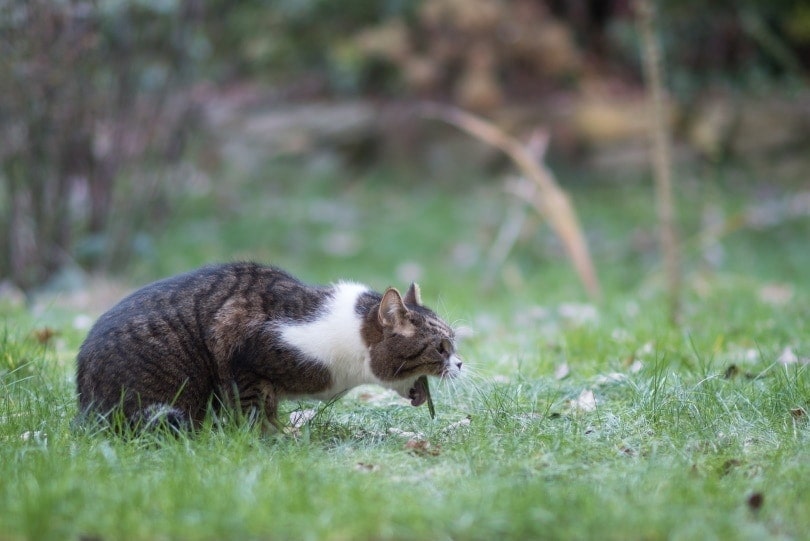Can Cats Eat Catnip? Vet-Reviewed Facts & Advice
Updated on

Most cat owners are not familiar with whether their cat can eat catnip or even if it’s safe. No evidence suggests that catnip is harmful for either adult cats or kittens to consume. There’s a possibility that eating too much catnip can cause them to have an upset stomach, accompanied by diarrhea and vomiting in severe cases.
So, you can ideally offer catnip to your cat in moderation. But even if your cat does consume large amounts of catnip, it should not be harmful to them.
What Is Catnip and How Does It Work?
Catnip (Nepeta cataria) is a plant that is a member of the mint family. The main active ingredient that gives cats the “euphoric” effect is nepetalactone. It’s produced in the bulbs coating the leaves, stems, and seed pods of the plant, and when these bulbs rupture, this chemical is released.
It’s for this reason that you may notice your cat chewing on the plant, as they’re attracted to the plant’s nepetalactone. The manipulation of the leaves causes an increase in the emission of this volatile oil.
Catnip is native to Europe and Asia, where it grows across the country near highways and roads. The plant is a grayish green and has jagged, heart-shaped leaves with thick stems covered in fine fuzz, which helps make identifying this plant easier.

Many experts believe that the chemical nepetalactone acts as a feline attractant that triggers a happy feeling response. Therefore, once your cat smells catnip, they will begin to roll on it, rub it, chew it, and otherwise try to release the oils in the plant’s leaves. The chemical then enters the cats’ sensory neurons via the vomeronasal organ, or Jacobson’s organ, located in the root of their mouth. The chemical substance turns into a sensory or electrical stimulus via this organ. The stimulus travels toward and stimulates the brain’s amygdala and hypothalamus. These areas of the brain control the cat’s emotions and behavior, which catnip most affects.
Catnip also mimics feline sexual hormones, which is why female and male cats will experience a response like a cat in heat, causing them to be overly affectionate, active, and playful. In higher dosages, your cat may even experience temporary alleviation from pain, discomfort, and anxiety.
Is Catnip Bad for Cats to Eat?
If your cat has decided to take a nibble at catnip plants you are growing or eaten a commercial bag of prepared catnip, there is no real risk you need to worry about. Catnip is safe for your cat to consume in small amounts, and they will still get to experience the positive side effects unless they’re eating large quantities of catnip regularly.
The catnip plant may even have anti-diarrheal properties, so small amounts of catnip can help improve your cat’s digestion. However, if your cat eats a large portion of catnip, it may experience adverse effects such as vomiting and diarrhea, which may need medical treatment.

What Happens to Cats When They Eat Catnip?
Observing your cat’s response to the effects of catnip can be entertaining. You may notice that they stumble around, seem disorientated, and hyperactive by jumping around and playing with toys or the air. In some instances, your cat may even drool or take a relaxing nap. An improved mood and relaxed state are common responses that most cats will experience. However, there have also been reports of cats turning aggressive after coming into contact with catnip, especially if they perceive a catnip plant as their territory and another cat tries to approach.
For most cats that have a positive experience with catnip, they will become very mellow. This is why so many cat owners recommend using it on hyperactive cats. But catnip will only produce this effect in your cat for 10 to 15 minutes before it wears off. The volatile oil concentration on a specific plant and the amount of catnip that your cat eats or sniffs will cause them to experience a stronger or milder effect.
Interestingly, kittens cannot respond to catnip as adult cats do, but they will develop it once they reach sexual maturity or around 3 to 6 months of age.
The best toys will give your cat hours and hours of exercise and entertainment. Our Hepper Catnip Stick Toys are packed with 100% organic catnip and shaped like prey to give your cat both mental and physical stimulation. Plus, they're as nice to look at as they are sturdy and fun!
How Much Catnip Can Cats Eat?
When you’re offering catnip to your cat or adding it to their food, it is best to start with a small amount and gradually increase it as needed, based on your observations. Remember that eating too much catnip can give your cat diarrhea, and you want to avoid this. Each cat is different, so you will have to find the sweet spot for your cat.
Conclusion
It is reassuring to many cat owners to know that catnip is safe for their cats to eat. If you’re vigilant with how much catnip you give your cat and start by offering small amounts while closely observing them, you will be able to find the right amount for your cat. With these precautions and by gradually increasing the amount only if needed, your cat can safely enjoy the catnip that you give them.
Featured Image Credit: Creative Cat Studio, Shutterstock















